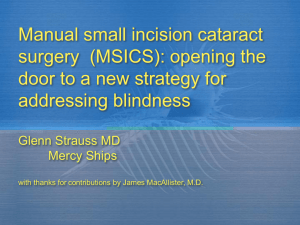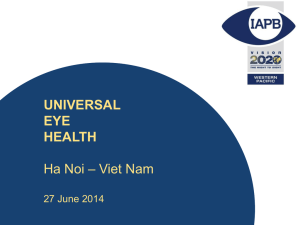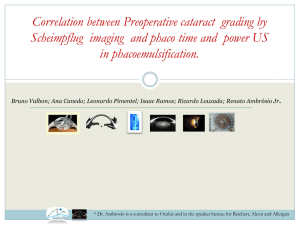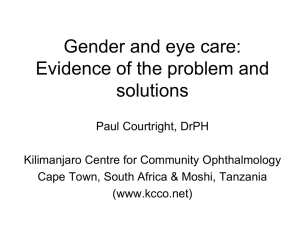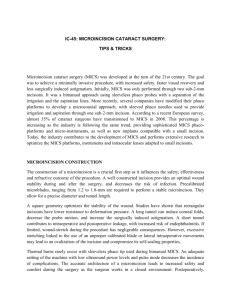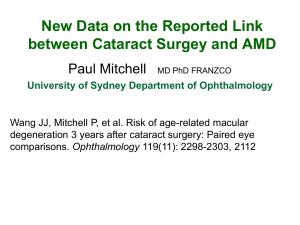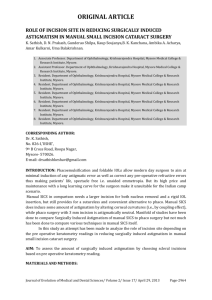For treating advanced cataracts in the Developing World
advertisement
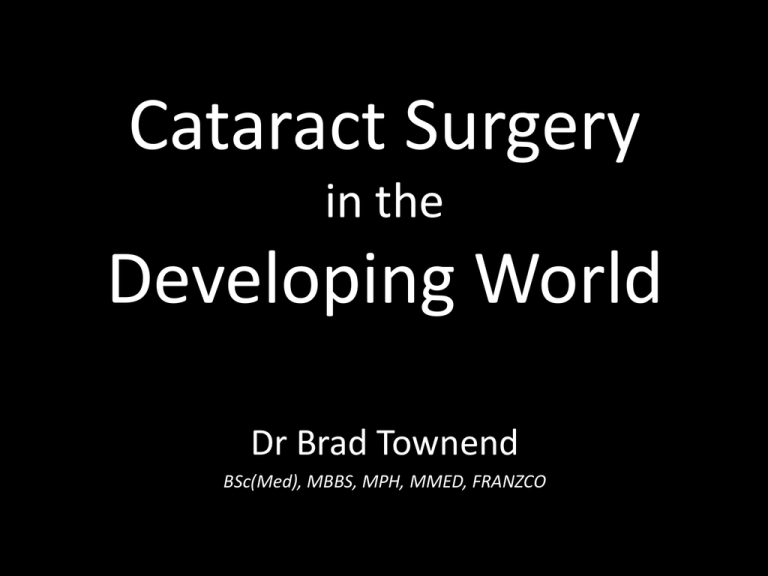
Cataract Surgery in the Developing World Dr Brad Townend BSc(Med), MBBS, MPH, MMED, FRANZCO A Blinding Problem… • Cataract is the leading cause of blindness in the world – Defined as VA <6/120 • More than 20 million people in the world ‘blind’ due to cataract • 1999: International Agency for the Prevention of Blindness (IAPB) and the World Health Organization (WHO) “Vision 2020: The Right to Sight” initiative. • Mission: sustainable provision of high-quality cataract surgical services throughout the underdeveloped world. • At the start: number of people blinded by cataract projected to double by year 2020 if no improvements in global eye care delivery • Significant progress has been made in quantity and quality of cataract surgery provided in Developing World Q1: What is the leading cause of blindness in the world? A B C D Cataract Glaucoma AMD Infection / Uveitis Intracapsular Surgery • • • • • No IOL technology Large wound Zonule dissolving solution, cryo probe Time consuming surgery Ocular complications significant – RD, CMO, expulsive haemorrhage, infection • Significant morbidity (weeks in hospital) • Remain aphakic with spectacle correction Harold Ridley • WWII Royal Air Force casualties • Splinters of plastic (acrylic) from shattered aircraft cockpit canopies became lodged in the eyes of wounded pilots • Inert (did not trigger rejection or inflammation) • artificial lenses for cataract surgery • Much opposition from the medical community initially • Finally approved by FDA as ‘safe and effective’ for human use in 1981 Q2: Harold Ridley implanted the first IOL in 1950 made of what material? A B C D Glass Silicon Quartz Acrylic / Perspex Extracapsular Surgery – Preserve capsule for IOL insertion – 10 mm limbal incision (astigmatism) – 8-10 sutures • Astigmatism, time, suture removal, complications – Slow visual rehabilitation Phaco-Emulsification • • • • Better refractive and visual outcomes Quicker surgical time (sutureless) Fewer complications Fast rehabilitation BUT • • • • High cost of equipment Maintenance Consumables Most blind people live in developing world Q3: Which of the following is a disadvantage of phaco-emulsification over traditional extracapsular surgery? A B C D Faster rehabilitation time Astigmatism Cost No need for sutures SICS Small Incision Cataract Surgery • Good quality outcomes • Cheap ($20 AUD per case) – – – – • • • • Cheap tools Cheap lenses No phaco machine Few consumables (except blades) Efficient surgical times (5 minutes) and turnaround times (3 minutes) Sutureless Much easier and quicker to learn than phaco More forgiving than phaco when complications – Particularly for difficult dense cataracts • Can’t do SICS on soft Western cataracts! • Much fewer post-op visits than ECCE • Better VA outcomes than ECCE, and almost as good phaco Q4: Which of the following is a limitation of SICS surgery? A B C D Cheap Difficult to perform on soft Western cataracts Efficient surgical times Astigmatism OUTCOMES: SICS vs Phaco in Developing World • • • • • • • 3 RCT’s Phaco: more corneal oedema on day 1 post-op with worse VA on day 1 No significant difference in endothelial cell loss between techniques at 6 weeks Phaco had higher rates of UCVA >6/9 and BCVA >6/6 compared to SICS At 6 months: rate of BCVA and UCVA >6/18 similar between phaco and SICS Phaco took 15.5 mins on average, SICS took 9 mins PCO rate significantly higher in SICS group at 6 months (but VA not worse!) – Needs longer follow-up • Complication rates (including endophthalmitis) similar • BUT: – SICS more efficient and economical – SICS faster visual rehabilitation (For treating advanced cataracts in the Developing World) Q5: Which of the following is true for treating advanced cataracts in the Developing World? A B C D SICS is more efficient, economical and has outcomes that are just as good as phaco SICS causes more corneal oedema than phaco Phaco has quicker post-op rehabilitation SICS has more complications References • Gogate P, Deshpande M, Nirmalan PK. Why do phacoemulsification? Manual small-incision cataract surgery is almost as effective, but less expensive. Ophthalmology. 2007;114:965–968. • Gogate PM, Kulkarni SR, Krishnaiah S, et al. Safety and efficacy of phacoemulsification compared with manual small-incision cataract surgery by randomized controlled clinical trial. Ophthalmology. 2005;112:869–874. • Ruit S, Tabin G, Chang D, et al. A prospective randomized clinical trial of phacoemulsification vs manual sutureless small-incision extracapsular cataract surgery in Nepal. Am J Ophthalmol. 2007;143:32–38. • Ruit S, Tabin GC, Nissman SA, Paudyal G, Gurung R. Low-cost high-volume extracapsular cataract extraction with posterior chamber intraocular lens implantation in Nepal. Ophthalmology. 1999;106:1887–1892. • Tabin G, Chen M, Espandar L. Cataract surgery for the developing world. Curr Opin Ophthalmol. 2008;19:55–59. FIJI NEPAL ALICE SPRINGS EYE CHART: How to be cruel to old guys!
